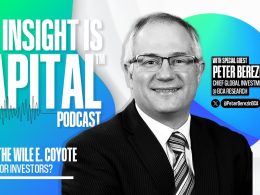by William Smead, Smead Capital Management
Many times in my 32-year career people ask me to comment on whether an established trend for a popular investment will stay intact. The most recent example was last year (2012) when our firm was asked on numerous occasions to comment on the stock of Apple. My answer is always the same. We don’t know when the hot streak will end for the popular investment and we don’t feel comfortable with popular securities.
In our view, there is a dramatic difference in what you do with popular investments based on whether they are—to use terms borrowed from Warren Buffett— currency assets, unproductive assets, or productive assets. It has to do with the ability to sell and the liquidity you have when the popularity disappears.
Currency assets, for instance, bear interest and include money market funds, certificates of deposit, and all forms of bond investments. If they have a maturity date, the guarantor is trust-worthy and you can hold them to the maturity date; your risk is limited to the opportunity cost and the loss of buying power via inflation. The bid and liquidity is undergirded by the final maturity and the automatic reestablishment of its attractiveness in relation to the prevailing interest rates.
Productive assets, on the other hand, come is three forms: ownership of a business (including partial ownership via common stock), ownership of working farmland, and ownership of real estate (commercial or residential) which produces rent. These types of investment can get beat up badly as they move from popular to unpopular over the years. They are riskier if they have debt attached to them, but theoretically they have intrinsic value. Their intrinsic value is the net present value of their future income stream. Therefore, at some lower price, buyers are attracted to owning the productive assets. In other words, bids and liquidity are driven by an economic reward.
I’m bringing this up on February 26th, 2013 because it is possible that the US Federal Reserve Board is closer to allowing short-term interest rates to be governed by market forces. If they do, the asset allocation landscape could get turned on its ear. Formerly popular investments could quickly become very unpopular and do it without providing liquidity on the way down. Our purpose in writing this missive is to compare how these three asset categories trade under great duress because some of them could have no bid or liquidity.
If you own long-term bonds and interest rates rise significantly, you will get clobbered. If you buy $100,000 of a 3% coupon AA-rated corporate bond due in 30 years at par and three years from now the 27-year rate is 6%, you are sitting on unrealized losses of $39,000. Combining that with the 3% annual coupon means that you lost 30% of your money in three years. During those three years you would have had numerous opportunities to sell because someone would be bidding along the way based on the newly higher prevailing interest rates. There is always liquidity and a bid.
On a cash basis, productive assets can also get clobbered like they did in 2008. Along the way there are bids to buy them based on new buyers’ urge to have a claim on the future cash flows. There is liquidity on the way down in both productive and currency assets. Even in 2008, the worst stock market year since the 1930’s, investors had numerous opportunities to sell along the way because there was liquidity.
Unproductive assets are things like art, collectibles and precious metals. Here is how Buffett explained this category:
The second major category of investments involves assets that will never produce anything, but that are
purchased in the buyer’s hope that someone else – who also knows that the assets will be forever
unproductive – will pay more for them in the future.This type of investment requires an expanding pool of buyers, who, in turn, are enticed because they
believe the buying pool will expand still further. Owners are not inspired by what the asset itself can
produce – it will remain lifeless forever – but rather by the belief that others will desire it even more
avidly in the future.
There is no rent, profit, or cash flow from unproductive assets. We call them bigger fool investments. They are great as long as bigger fools come behind you and want to pay a higher price. Their value is completely intangible.
Commodity futures contracts are a bet on the price change of a commodity and are the pulse of trading in unproductive assets. Gold, oil, and corn are examples of major commodities traded through these contracts. The futures contracts are primarily useful to producers of the commodity and to commercial interests which use the commodity. They allow producers to hedge against falling prices, while these contracts allow commodity users to hedge price increases. Since there are expenses associated with trading commodity futures, it is a negative-sum game. The winners make less than the losers lose; there are no future cash flows coming for other investors.
Thanks to the intense urge on the part of institutions and individuals to diversify their investments in the aftermath of the tech bubble, this is the first time in US history that investing parties have had a major participation in commodity futures. It is called an asset class. We must remember, though, that it is the only asset class which is functions like a negative-sum game. Think of it like blackjack or the craps table in Las Vegas, the house always gets a cut.
If our analysis is correct, rising interest rates could cause a sudden elimination of bids for gold, oil, and other commodities which have been the most popular way to bet on continued Federal Reserve Board suppression of interest rates. This is not the only asset class which is tied tightly to the trough at the Fed. By linking their currency to ours, the Chinese automatically subject themselves to tighter credit if we allow rates to rise. At the margin, they have been the biggest new force in almost every commodity traded in the US. Their energy use was up 97 percent from 2000-2011, and their citizens bought gold because they lacked attractive alternatives. The urban migration and export-driven success created demand for food to eat and building inputs for housing.
Allow us to put this all together. We believe that when the Federal Reserve allows short-term interest rates to gravitate to market interest rates and/or something causes the Chinese to slow their commodity demand, commodity markets will go back to being the domain of producers and commercial users. We believe you could wake up with no bid from institutions and high-net worth individuals for commodities and ETFs tied to commodities, which have been created due to the popularity of the asset class. This could very possibly be un-gradual. Think of a flash crash in the commodity pits. If we are correct and it is un-gradual, you could wake up with no bid for many unproductive assets and severe damage to commodity-producing countries and companies. When it comes to unproductive assets, there is no maturity date, no future interest payments, and no claim on the future cash flows of a productive asset. On the way down, there is likely going to be no bid and no liquidity. We believe that investors should include these thoughts in their analysis.
Best Wishes,
William Smead
The information contained in this missive represents SCM’s opinions, and should not be construed as personalized or individualized investment advice. Past performance is no guarantee of future results. It should not be assumed that investing in any securities mentioned above will or will not be profitable. A list of all recommendations made by Smead Capital Management within the past twelve month period is available upon request.
This Missive and others are available at smeadcap.com
Copyright © Smead Capital Management












